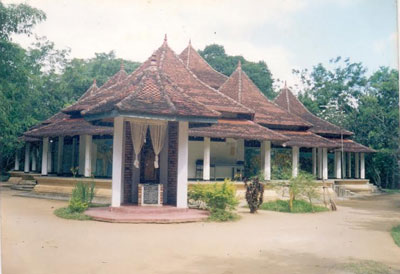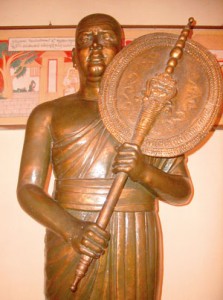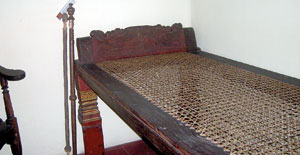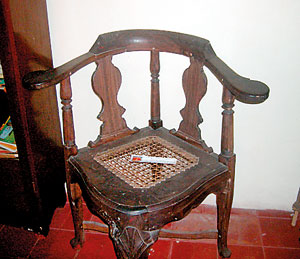On the trail of a Thera and his Upasampada mission here

The Bhikkhu hostel now being used as a cultural centre
From Vesak Full Moon Poya day which fell on May 20 this year until Poson Poya (today), the Malwatte and Asgiriya Maha Vihara have been conducting Upasampada ceremonies of the samanera (novice) monks of the Siam Nikaya (sect).
It is believed that the first Upasampada was conducted over 2600 years ago by the Buddha near the Sri Maha Bodhi in Buddha Gaya. During the Buddha’s time, there were eight ways in which Upasampada was conducted: The first was the Ehi Bhikku Upasampada where the Buddha himself conferred higher ordination on samanera.
The birth anniversary of Ven.Weliwita Asarana Sarana Saranankara Maha Thera who initiated the revival of Upasampada in Sri Lanka fell on June 18. He was one who believed that if the Buddha Sasana was to continue, there should be bhikkhus who have received Higher Ordination.
The second son of Kulatunga Nilame, who was well respected in the village of Weliwita in Thumpane Korale, born on June 18, 1698, he was named Kulatunga Banda. At the age of 12, he informed his father of his desire to enter the Buddhist Order. His father vehemently opposed his request as he did not want his son to be another Ganinnanse (pseudo-priest), who did not follow the tenets of Buddhism as taught by the Buddha.
However, as the boy was insistent, he was ordained as a samanera (student monk) with Suriyagoda Kithsirimevan Rajasundara Unanse as his teacher at the Yatinuwara Sooriyagoda Viharaya. Kulatunga Banda was named Welivita Saranankara.
With the passage of time Buddhism declined in the Kandyan areas due to the indifference of the kings, feudal chieftains and also the invasion by foreign powers.
Welivita Saranankara Thera could not receive Upasampada as there were no monks who had higher ordination at that time – the requirement being that there should be five such Theras to perform Upasampada on Samanera monks. He realized that if Buddhism was to survive in this country, Upasampada Theras should be brought from Siam (Thailand) or Burma to conduct higher ordination to re-establish the Buddhist Order.

Statue of Ven.Weliwita Saranankara Maha Thera at a museum at the Malwatte Maha Vihara in Kandy
Poson Poya is commemorated in the island as the day Arahant Mahinda Maha Thera arrived with an entourage of seven during the reign of King Tissa in Anuradhapura. Of the seven, Arahant Mahinda, Ittiya, Utthiya, Sambala and Bhaddasala had received higher ordination. The other two were Sumana Samanera and Bhanduka Upasaka.
With the visit of Arahant Mahinda Maha Thera, King Devanampiya Tissa became a Buddhist. Maha Aritta, a minister who had obtained permission from the King was ordained and is believed to be the first Sinhala Thera to receive Upasampada.
Weliwita Sangaraja Thera was keen anxious to re-establish Higher Ordination and train the people in the Dhamma way. However there were setbacks – the Thera’s teacher was accused of high treason by King Vira Parakrama Narendra Sinha and executed. Ven. Saranankara Thera retreated to the Alagalla mountain in Kadugannawa to live in a cave. The villagers having very little food, still provided whatever they could spare.
Hearing that Leuke Ralahamy was imprisoned by the King in Makehelwala, a village close to Alagalla, Weliwita Saranankara decided he wanted to learn Pali under him. Leuke Ralahamy had studied under Ven. Watapuluve Thera. But it was an offence to associate with a prisoner. Yet he was permitted to worship at a nearby Bodhi tree and there the Thera was able to meet him and learn Pali and the fourfold foundation of Meditation. As Leuke Rala’s grammar was limited, he studied grammar under Samanera Attadassi, another pupil of Ven. Watapuluve Thera. Weliwita Samanera wrote on velipila (sand strewn on planks) and improved his knowledge.
Living in this cave, engrossed in his studies, he was joined by three others who were also very much interested in the Dhamma. They were Sitinamaluve (from Beliatta, Matara), Ilipangamuwa (Nelundeniya, Kegalla) and Kadiragoda(Kurunegala). This group was named ‘Silvat Samagama’ (pious ones) by the people. A layman, Kanuketiyegedera of Satara Korale extended an invitation to the Thera. Weliwita Samanera Thera with the ‘Silvat Samagama’ accepted the invitation, travelled to Satara Korale and participated in religious activities. They proceeded to Unaliya (Kuliyapitiya) and there the Thera requested the villagers to polish ola leaves (Talipot) for writing.
The group thereafter proceeded to Udapola Korale and making Polgahawela their base, travelled to Satara Korale (Kegalle District) and Sath Korale (Kurunegala District) where the Thera taught the children to read and write. Students of Watapuluve Thera too joined this group as they were very much impressed with the work done by the Weliwita Thera. The people were taught Buddhist rites and practices which are followed to-date.
King Narendra Sinha had banishedWeliwita Saranankara to Laggala due to the complaints of the Ganinnanses that he was trying to oust the king, a baseless allegation.
Later, the king realized his mistake and sent his own palanquin and invited him back.
The Thera requested the King to set up a Pirivena (monastic educational institute). The King ordered his officials to build this pirivena in Niyamakanda near Embekke Devale in Udunuwara.

The bed used by Ven. Weliwita Saranankara, gifted by King Kirthi Sri Raja Sinha and the unusual triangular shaped chair (below), all found in the museum
Due to hazardous weather conditions and rough seas, the delegation reached the island only in January 1753. It is stated that they were received at Trincomalee and conducted in procession to reach Kandy after five days. They were accommodated at the Pushparamaya (Malwatta Viharaya) in Kandy. Upali Maha Thera decided that the building in the courtyard of the Viharaya which is now the Poyage was a suitable place to conduct Upasampada.
Ven. Kulugammana Dhammarakkhita Thera in his article ‘The Revival of Buddhism under Ven. Weliwita’ in the book Weliwita Sarankara Samgharaja Pranamaya compiled by Kandakkulame Dharmakirthi Himi states, “In the newly consructed hall (sima), the first upasampada ceremony was conducted by Siamese Upali Maha Thera, on Friday July 19, 1753. The first ceremony was conducted to confer Upasampada on novice (samaneras) from Siam who accompanied the delegation. This was done so that the local monks would become aware of rites.The following day being Esala Full Moon day (July 20, 1753) King Kirthi Sri Rajasinha, called over at the Malwatte Vihara and having paid due respect to the Siamese prelates, offered a fan (Vatapatha made of Ola) to Upali Maha Thera and requested him to conduct the ceremony in Sri Lanka.
The Chief Monk of Malwatte Vihara Kobbekaduve Unanse who was still a Samanera was the first to be conferred Upasampada, as he was senior in the order to Weliwita Saranankara. Subsequently,Weliwita Saranankara Thera, Hulangamue Samanera, Bambaradeniye Samanera, Tibbatuwawe Samanera and the Chief Thera of the Asgiriya, Ven. Navinne Samanera were ordained by Ven. Upali Maha Thera.
Kirthi Sri Rajasingha offered a vatapatha (Bhikku fan) to Weliwita Saranankara and proclaimed “from today, I appoint you the Sangha Nayaka Thero of Tri Sinhala – the whole island of Lanka divided into three provinces.” (Ref. Ven.Kandakkulame Dharmakirti Thera, Sarankara the last Sangha-Raja of Sri Lanka).
Todate, at the Malwatte Viharaya, the Upasampada ceremony is conducted within the seema (consecrated area) in the Poyage. A second ‘seema’ was consecrated at the Asgiriya Gedige Viharaya to conduct Upasampada ceremonies.
The new Order is known as Syamopali (meaning the fraternity of Upali of Siam) Maha Nikaya – the Malwatte is known as Syamopali Maha Nikaya Malwattu Parshawaya (Malwatte Chapter of the Siamese Sect) and Asgiriya as Shiyamopali Maha Nikaye Asgiri Parshawaya (Asgiriya Chapter of the Siamese Sect).
Today the birthplace of Welivita Sangharaja, Watte Walauwwa, Weliwita of the Sangharaja in a dilapidated state. S.B. Weliwita, an eighth generation member of the Weliwita family lamented that the authorities are not taking much interest in renovating the house where Weliwita samanera lived. In 1969, then Minister of Cultural Affairs E.L.B. Hurulle had discussed with his father P.B. Weliwita and constructed the Weliwita Memorial Conference Hall and Bhikkhu Hostel in Weliwita . At present the Bhikkhu hostel does not house the samaneras and is used only as a Cultural Centre to teach Kandyan dancing and conduct English language classes, losing the main purpose for which this building was built. Mr. Weliwita hopes that the authorities will take some interest to re-establish the Bhikkhu hostel.
There is a Weliwita Sangharaja Museum at the Malwatte Maha Vihara in Kandy. The late Weliwita Dharmakeerthi Thera set up this museum collecting items used by the Sangharaja Thera and his valuable ola leaf manuscripts. On March 4, 1995, the museum was opened by Ven. Kirinde Sri Dhammananda Maha Thera, Chief Sangha Nayaka of Malaysia and Singapore.
The vatapata (bhikkhu fan) with an exquisitely carved ivory handled offered to the Weliwita Asarana Saranankara on his appointment as the Sangharaja by King Kirthi Sri Rajasinha is displayed at this museum.
At the entrance is a statue of the Sangharaja. There are many items including a kunama (palanquin) which was gifted by King Weera Parakrama Narendra Sinha, a Randoliya , palanquin used by queens and princes, a pallekkiya, entirely built of wood used by chiefs of provinces, ridi poth kamba (silver book wrappers) a gift to the Sangharaja from an aunt of Keerthi Sri Rajasinha, the dandasanaya (wooden rest), a collapsible device with woven cloth where puskolapoth (ola leaf manuscripts) were placed for reading, stones used for polishing and glazing the Ola leaves and the bed used by the Sangharaja which was gifted by King Kirthi Sri Raja Sinha. The chair is an unusual triangular shape. There is also Mukkali Bankuwa, a three legged bench where the King sat when he visited the Sangharaja. Some robes are placed in a glass case as well as a patraya(begging bowl) a gift from the king of Siam which the Sangharaja used on his Pindapatha(alms round). Books of the Sinhala alphabet, alphabets of six other languages (Sangharaja had a knowledge of six languages), Visuddhi Magga (Path of Purity), Jataka stories and many other manuscripts on Ola leaf are preserved in the museum as well as other items.
At the temple, we met Upadyaya Durandara Agramaha Panditha, the Most Venerable Aluthgama Sri Dhammarakkita Piyadassi Dhammananda Maha Thera of the Malwatu Maha Viharaya. Born on November 22, 1915 in Thumpane, he is now 100 years old. To honour the Ven. Weliwita Sangharaja, every Esala (July) Poya day a Sangharaja Perahera is conducted since 1947 through the city of Kandy and finally returns to the Thumpane Temple in the Malwatte Viharaya. The Maha Thera explaining further said that as the Sangharaja passed away on a day after an Esala Poya, irrespective of the exact date, an alms giving is arranged every year on the day following Esala Poya, to bestow merit on Weliwita Sangharaja. This year too the Maha Thera is making arrangements for an almsgiving for 50 members of the Sangha on July 20, the day after Esala Poya.
| The forgotten abodeToday the birthplace of Weliwita Sangharaja, Watte Walauwwa, Weliwita of the Sangharaja is in a dilapidated state. S.B. Weliwita, an eighth generation member of the Weliwita family lamented that the authorities are not taking much interest in renovating the house where Weliwita samanera lived. In 1969, then Minister of Cultural Affairs E.L.B. Hurulle had discussed with his father P.B. Weliwita and constructed the Weliwita Memorial Conference Hall and the Bhikkhu Hostel in Weliwita . At present the Bhikkhu hostel does not house the samaneras and is used only as a Cultural Centre to teach Kandyan dancing and conduct English language classes, losing the main purpose for which this building was built. Mr. Weliwita hopes that the authorities will take some interest to re-establish the Bhikkhu hostel. There is a Weliwita Sangharaja Museum at the Malwatte Maha Vihara in Kandy. The late Weliwita Dharmakeerthi Thera set up this museum collecting items used by the Sangharaja Thera and his valuable ola leaf manuscripts. On March 4, 1995, the museum was opened by Ven. Kirinde Sri Dhammananda Maha Thera, Chief Sangha Nayaka of Malaysia and Singapore. The vatapata (bhikkhu fan) with an exquisitely carved ivory handle offered to the Weliwita Asarana Saranankara on his appointment as the Sangharaja by King Kirthi Sri Rajasinha is displayed at this museum. At the entrance is a statue of the Sangharaja. There are many items including a kunama (palanquin) which was gifted by King Weera Parakrama Narendra Sinha, a Randoliya , palanquin used by queens and princes, a pallekkiya, entirely built of wood used by chiefs of provinces, ridi poth kamba (silver book wrappers) a gift to the Sangharaja from an aunt of Keerthi Sri Rajasinha, the dandasanaya (wooden rest), a collapsible device with woven cloth where puskolapoth (ola leaf manuscripts) were placed for reading, stones used for polishing and glazing the Ola leaves and the bed used by the Sangharaja which was gifted by King Kirthi Sri Raja Sinha. The chair is an unusual triangular shape. There is also Mukkali Bankuwa, a three legged bench where the King sat when he visited the Sangharaja. Some robes are placed in a glass case as well as a patraya(begging bowl) a gift from the king of Siam which the Sangharaja used on his Pindapatha(alms round). Books of the Sinhala alphabet, alphabets of six other languages (the Sangharaja had a knowledge of six languages), Visuddhi Magga (Path of Purity), Jataka stories and many other manuscripts on Ola leaf are preserved in the museum as well as other items. At the temple, we met Upadyaya Durandara Agramaha Panditha, the Most Venerable Aluthgama Sri Dhammarakkita Piyadassi Dhammananda Maha Thera of the Malwatu Maha Viharaya. Born on November 22, 1915 in Thumpane, he is now 100 years old. To honour the Ven. Weliwita Sangharaja, every Esala (July) Poya day a Sangharaja Perahera is conducted since 1947 through the city of Kandy and finally returns to the Thumpane Temple in the Malwatte Viharaya. The Maha Thera explaining further said that as the Sangharaja passed away on a day after an Esala Poya, irrespective of the exact date, an alms giving is arranged every year on the day following Esala Poya, to bestow merit on Weliwita Sangharaja. This year too the Maha Thera is making arrangements for an almsgiving for 50 members of the Sangha on July 20, the day after Esala Poya. |


